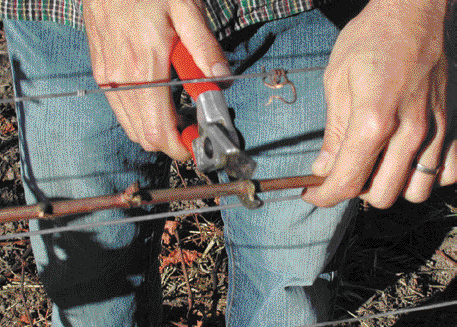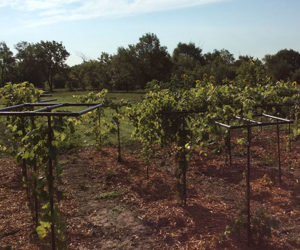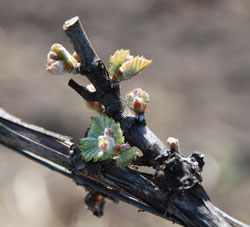 To understand how pruning your backyard grapevines will affect growth, crop load and wine quality, you must first understand how grapevines grow in the wild. When vines sprout from seed, the vine usually begins its life in the shade of a tree or bush. Generally, unless head-trained in a short, stubby fashion, all grapevines need a support system.
To understand how pruning your backyard grapevines will affect growth, crop load and wine quality, you must first understand how grapevines grow in the wild. When vines sprout from seed, the vine usually begins its life in the shade of a tree or bush. Generally, unless head-trained in a short, stubby fashion, all grapevines need a support system.
In its native environment, the grapevine uses a pre-existing tree or bush as its trellis. For a few years it will grow slowly to establish a root system, and then it will begin to twist and tangle its way up the bush or tree’s trunk in an effort to get to the top and find a source of direct sunlight.
As Pasteur once said, “Wine is sunlight held together by water.” Think of a grapevine as a sun parasite. The vine grows until it reaches the top of a tree or bush and then spreads out to “steal” the sun from its host. Vines are competitive. If they don’t grow fast enough to compete for nutrients (roots) and sunlight (leaves and fruit), they won’t be able to survive and reproduce. So what does this have to do with pruning a grapevine in your backyard? When humans tamed the grapevine and created vineyards, we soon discovered that vines require pruning, lest they turn into a mass of tangled, overgrown, unproductive canes.
1. When should I prune?
Pruning is generally done after the vine has been completely bare for at least a month. This is generally in the winter, between mid-December to March, depending on which part of the country you are in. I like to make a test-cut in my vine and see if any xylem fluid (it looks like water) runs from the wound. Vines turn whatever nitrate nitrogen remains in their wood into arginine for the next season’s growth. It’s important not to hinder this process by pruning too early. Once a new pruning wound stays relatively dry the vine is completely dormant and ready for pruning. If you live in an extremely cold climate, there may be other factors involved in pruning and timing the practice. Always seek out professional viticulturists or nurserymen in your area to aid you in the timing of your pruning.
2. Why should I prune?
There are a number of goals to keep in mind while we prune. Among these are:
- To space out shoots, to allow sunlight penetration to the fruit, to allow spray applications to reach the fruit and inside of the canopy, and to allow air circulation in the canopy to lower the chance of rot and mildew. I like to have a hand’s width between each shoot on the trellis. Sun exposure on the fruit is vital for flavor development. The more sun on the fruit, without burning or raisining, will promote color, phenolics, and discourage vegetal (pyrazine) flavors.
- Make sure you leave renewal spurs (two-bud spurs on the trunk or head of the vine) to create “fruiting wood” for future vintages. (This only applies to cane pruning!) Keep in mind that everything you do while pruning will affect the next two years of growth on each vine. Think about next year’s growth when choosing fruiting wood, and think about the following year when choosing renewal spurs.
- Leave a finished, pruned vine that has just enough viable “buds” or “eyes” to produce a crop of fruit that is appropriate to the vine’s vigor and the quality of wine you wish to produce. This requires some trial and error. Can you produce quality fruit at 3 pounds per vine? Maybe you can take it up to 7 pounds per vine without losing much intensity. Sometimes less fruit per vine will make the resulting wines more intense and complex. The more buds you leave, the more crop you will produce.
3. How Should I Prune?
No matter how much you read on the subject of pruning grapevines, you will never understand the process of pruning until you have tried it for a few consecutive seasons. Like me, you will make mistakes. But unless you cut the trunk of the vine from the root system, you won’t kill the vine or stop it from producing fruit. The improvement in wine quality and a decreased incidence of disease is significant if it’s done right. Here are a few general suggestions:
Prune in a way that keeps your canopy open to air and sunlight. This will reduce pests, rot, mold, mildew and off flavors in your wine. There are other practices that can help open up the canopy, including pulling off non-fruitful shoots a few months into spring growth and plucking some leaves from around the fruiting zone.
Get an experienced grapevine pruner to guide you the first few times you prune. Avoid over-cropping your vines. Too many clusters in relation to leaf number (I like 15 to 20 leaves on the vine per cluster of fruit) will result in low sugars, increased acidity and delayed maturity. This cluster-to-leaf balance is crucial. The solution to this problem is to leave less buds on the vine during pruning, or to drop some of the fruit at or before “vérasion” (fruit-softening).
Pruning is basically cutting off unwanted canes to allow the vines to produce a smaller and more intensely flavored crop the following year. This is accomplished by using bypass pruners to cut off approximately 90 percent of the past year’s cane growth, retaining only a few canes for fruit production in the upcoming season.
There are three basic pruning styles: spur pruning, the simplest and most common method for backyard vines; the more complex and time-consuming cane pruning; and the old-fashioned, less common method of head training.
The three basic pruning styles:
1. Spur Pruning
Spur pruning is most effective, most popular and most appropriate for vines of medium to high vigor. Classic grape varieties like Cabernet Sauvignon, Merlot and Syrah are most often spur pruned. Spur pruning is the pruning style of choice for backyard vineyards and vines that are trained on fences and other simple trellises. The reason for its popularity is that spur pruning is easy to do and easy to teach. It’s basically like giving the grapevine a short haircut, retaining one “arm” on the fruiting wire as a permanent “cordon,” and trimming back the spurs on the vine (to 2 to 3 buds) each year to limit the growth. Just walk down the vine row and chop all of the dormant canes down to “spurs” of two (or three) dormant buds. By a spur I mean a dormant cane that has been cut back to only a few inches, with only two or three visible “buds” on its length. Once in a while there will be a dead section on a vine and you might compensate by leaving one extra bud on an adjacent spur to fill out the canopy.
You’ll need to learn how many buds to leave on your vines, and how your decision influences vine growth, vigor and fruit production the next two years. Experiment, make the wine and then decide what is the best spur-pruning style for you. Don’t worry to much about hurting or damaging the vine; it is stronger than you think.
The disadvantage of spur pruning is that all of the buds that are retained are considered “basal” or adjacent to the main arm or trunk of the vine, which means they are less fruitful in cool or cold climates. Another problem is that individual spurs can die, which will leave gaps in the canopy.
2. Cane Pruning
Cane pruning is most popular in Burgundian-styled vineyards (Pinot Noir, table grapes and other lower vigor, cool climate grape varietals). Say you are looking at a dormant vine that you want to “cane prune.” It looks something like a Medusa having a bad hair day. Canes are sprouting all over the place, and the vine needs to be “tamed.”
First locate two canes that appear to be healthy, thicker than a pencil, but less than three times as thick as the same pencil. Canes tend to be less fruitful if they are too big. Try to choose the canes that have been in a position to receive excellent sun exposure over the past growing season. Now retain those canes and cut everything else off. The only other material you want to retain is a couple of stubby, two-bud spurs down on the head of the vine to help make “renewal canes” for the year after next.
Now remove all the excess cut canes from the trellis wires and wrap one cane going one way on the fruiting wire (tie it down firmly with a wire twist-tie), and then the other retained cane going the other way on the fruiting wire (away from the vine’s “head”). I make a cut right through the last bud, which makes a bump so the twist-tie doesn’t slip off the end. The ends of the canes should be cut so that the tip of one cane should meet the tip of the cane tied on the wire from the adjacent vine. This way there is “new wood” on every inch of your fruiting wire, and only one cane, so the canopy will not be congested when the vines start to grow. This is the “bilateral cane-pruned” system of vine training.
The advantages of cane pruning are: frost protection, even production, even spacing of growing shoots in the spring, allowing sunlight into the canopy if a vertical-type trellis is used, and using new wood yearly.
The major disadvantage of cane pruning is shading, along with the time it takes, the cost and the expertise necessary to do it right. Educated choices are required for every vine. How many buds per shoot are you going to leave? Are you going to retain only one cane per fruiting wire, or wrap two for higher production? Which canes will you retain and why? These decisions require a trained eye, but you can still make mistakes. Fortunately for all of us, vines are hard to kill.
3. Head Trained:
Unless you’re growing Zinfandel or you’re up for a serious challenge, I recommend leaving head-training to the experts. Head-training is a style of pruning meant for vineyards without trellising. Head-trained vines look like stunted trees, and give little support to the vines save their own mature wood. If you’re still interested, I’ve been told to prune the vine like a goblet — keeping the center hollow, developing a short trunk and pruning the spurs up in a circular pattern, in the shape of the rim of a glass.
The main advantage of head training is obvious — it’s cheap. The disadvantages include: the vine toppling under its own weight; a congested canopy, which makes it an easy target for mildew and rot; and it can be difficult for sunlight to reach the fruit.
Be creative with your pruning. Now that you know the basics of grapevine physiology and how pruning affects the growth and fruit quality, you can learn to custom-prune your vines through experimentation and careful observation.







